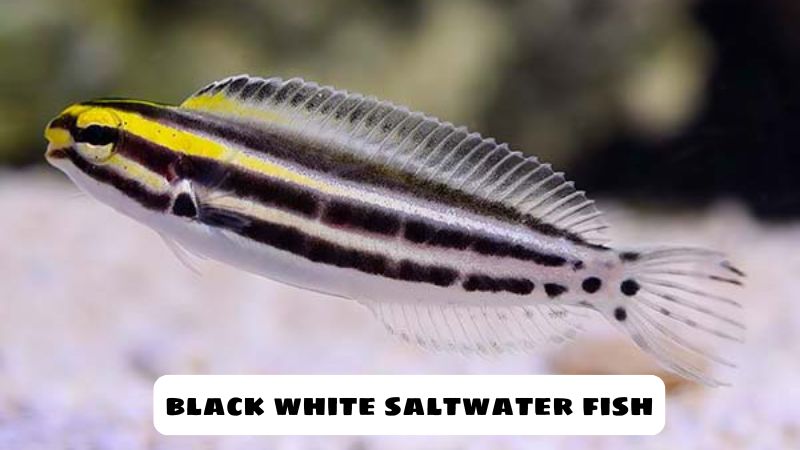Fish Species
Black White Saltwater Fish: Meaning For Humans
Black white saltwater fish, with their striking colors and patterns, attract the attention of both aquarium enthusiasts and biological researchers. The combination of white and black not only creates unique beauty but also reflects their survival strategies and ecological role in the ocean.
Let’s join Fishtankfables to learn about these black and white salty fish that help us better understand biodiversity and the importance of marine ecosystems.
Black white saltwater fish
1. Seahorse
Seahorses are one of the favorite aquarium fish thanks to their unique shape and attractive appearance. Some species of seahorses have striking black and white colors, such as:
Black-and-white seahorse with black dots: This seahorse has a mostly white body with evenly distributed black dots, creating a clear and beautiful contrast.
Striped black and white seahorse: With black and white stripes running along its body, this seahorse has an impressive and distinct appearance.
2. Clownfish
Although clownfish are commonly known for their characteristic orange-white color, some clownfish species also have contrasting black-and-white colors. For example:
Black and white clownfish: With a combination of white and black stripes or spots, this clownfish provides a striking and attractive appearance, different from traditional clownfish.
3. Lionfish
Lionfish, with their luxurious beauty, there are some species whose body colors are mainly black and white. These lionfish species often have:
Black and white lionfish: The combination of white and black creates a unique beauty, attracts attention and is suitable for aquariums that need to be different.
4. Butterfly fish
Butterfly fish are famous for their diverse shapes and colors, with some species featuring black and white colors. For example:
Black and white butterfly fish: The black and white stripes on the butterfly fish’s body create a striking and eye-catching design, increasing the beauty of the aquarium.
5. Stingray
Some species of rays have a combination of white and black patterns on their bodies, creating a wonderful blend of colors:
Black and white stingray: The black and white patterns on the stingray’s body often create beautiful shapes and patterns, making this fish a popular choice in marine aquariums.

General characteristics and ecological roles of black and white saltwater fish species
1. Camouflage
The black and white colors on the bodies of many saltwater fish species not only create outstanding beauty but also have an effective camouflage function in their natural habitat. The combination of white and black stripes or spots helps the fish blend in with environmental elements such as rocks, coral reefs, or water bodies with scattered light. This helps fish avoid detection by predators and reduces the risk of predation, contributing to the survival and conservation of the species.
2. Warning
For some fish species, black and white colors are not merely camouflage but also act as a warning signal. Bright and contrasting colors can warn enemies of danger or discomfort if attacked. For example, fish with warning colors often have special toxins or defenses that help them avoid predation and increase their ability to survive in harsh ocean environments.
3. Communication
The colors and patterns on the bodies of black and white fish also play an important role in communication between individuals of the same species. Distinctive patterns and colors help individuals identify each other, establish territories, and attract mates during the breeding season. This communication is important in maintaining the social structure and reproductive behavior of the species, and creates consensus and organization within the fish community.
4. Role in the food chain
Black and white saltwater fish play an important role in the ocean’s food chain. They are not only a food source for many larger fish species but also contribute to maintaining ecological balance in the marine ecosystem.
By consuming smaller organisms or becoming food for other fish, black and white fish help regulate the number and distribution of species in the habitat, thereby maintaining stability and health. health of the marine ecosystem.
Habitat and behavior of black and white saltwater fish
1. Coral reefs
Many species of black-and-white saltwater fish choose to live in coral reefs, a rich and diverse ecological environment. Coral reefs provide fish with shelter and protection from predators, as well as a rich source of food.
Coral reefs often contain many small organisms and plankton, which are the main food source for these fish. Their black and white colors help blend in with the surrounding environment, making it easy for fish to find food and avoid being detected by enemies.
2. Deep ocean
Some species of black-and-white saltwater fish live in deep seas, where sunlight does not reach. Deep-sea environments often have high pressure and low temperatures, creating a different habitat than shallower seas.
These fish species are often able to adapt to harsh conditions and develop special physiological characteristics to live in dark and high-pressure environments. The black and white coloration may help them blend in with deep-sea environments, where light is low and darkness is frequent.
3. Habit of living alone or in groups
Depending on the species, black and white saltwater fish can have solitary or group living habits. Some fish species are solitary, often searching for food and breeding alone, while others live in schools. Living in groups helps fish protect each other from predators and enhances their ability to find food.
Social fish species often use group communication and coordination behaviors to ensure survival and success in finding food.
4. Food
The food of black and white saltwater fish is very diverse, from plankton to other small animals. They can eat small organisms such as shrimp, crabs, and plankton that live in coral reefs or deep ocean environments.
Some fish species are predatory or omnivorous, which helps them maintain a balanced and nutritious diet. Eating a variety of foods also helps fish adapt to different environmental conditions and enhances survival in the wild.
The meaning for humans of black and white saltwater fish
1. Ornamental fish
Many species of black and white saltwater fish are raised as ornamental fish, contributing to the beauty of human living space. With outstanding colors and unique shapes, these fish not only create a decorative highlight for the aquarium but also bring a feeling of relaxation and enjoyment to the owner.
The variety of colors and patterns of black and white fish enhances the beauty of aquariums, enriches living spaces and facilitates mental relaxation.
2. Food source
Some black and white saltwater fish species have high economic value and are exploited for food. These fish species are often caught in the wild or farmed to supply the food market. They provide a source of protein and essential nutrients for humans, while also creating employment opportunities for communities dependent on fishing.
The exploitation and consumption of these fish species also contributes to the global economy, and requires sustainable management to protect marine resources.
3. Scientific research
The study of black and white saltwater fish species is important in better understanding marine biodiversity and marine ecosystems. These studies help us learn about the biology, behavior and habitat of fish species, thereby shedding light on the complex ecological relationships in the ocean.
These studies not only provide important information about the development and conservation of fish species but also help improve management strategies and protect the marine environment. At the same time, research also supports the development of medical and biotechnology applications from these fish species.
Epilogue
Black white saltwater fish not only stand out with their unique colors and patterns but also play an important role in many fields. They beautify living spaces, provide valuable food and support scientific research on marine biology.
The diversity and value of these fish species contribute to raising awareness about environmental protection and maintaining ocean ecological balance.

